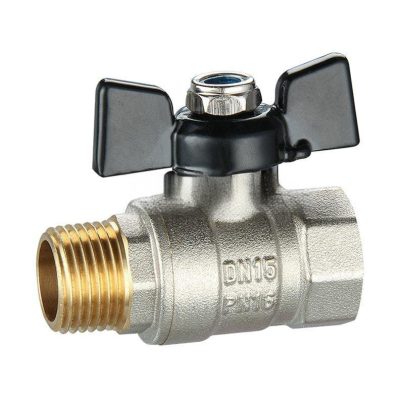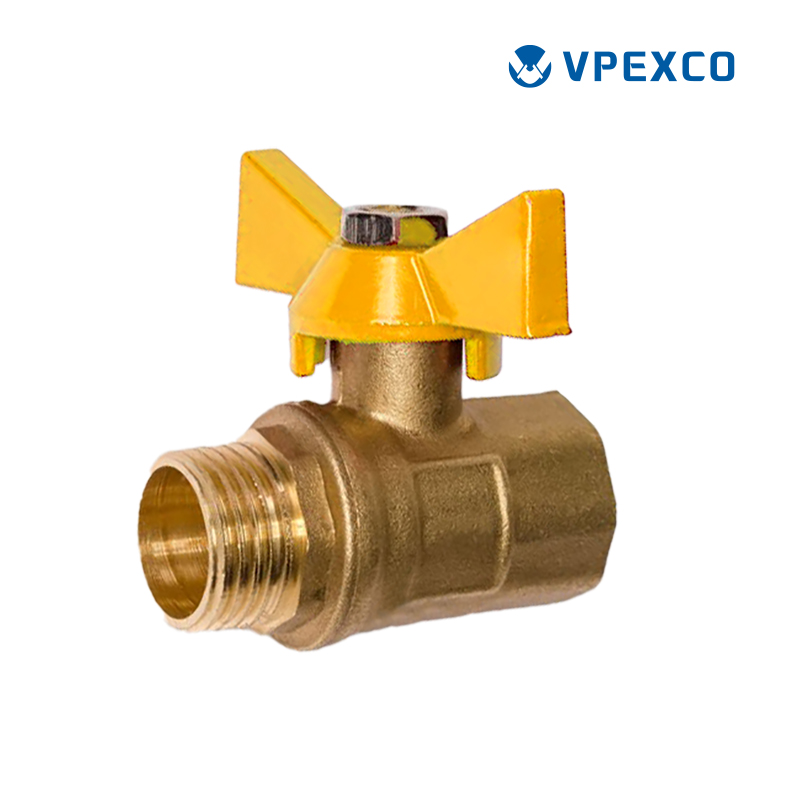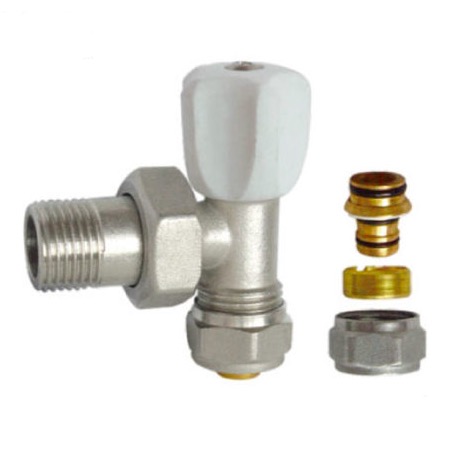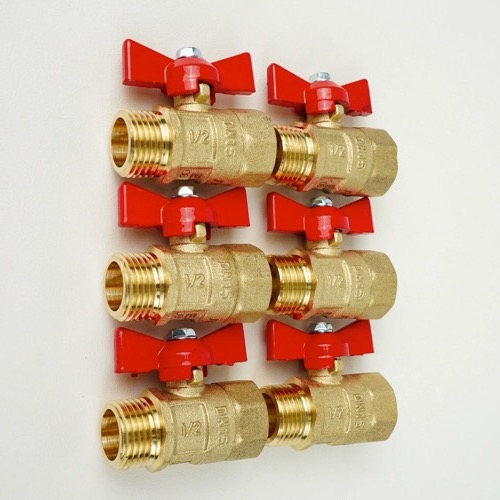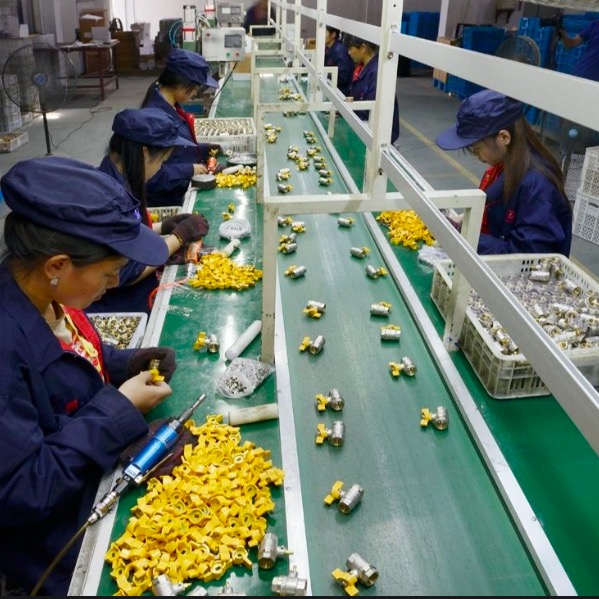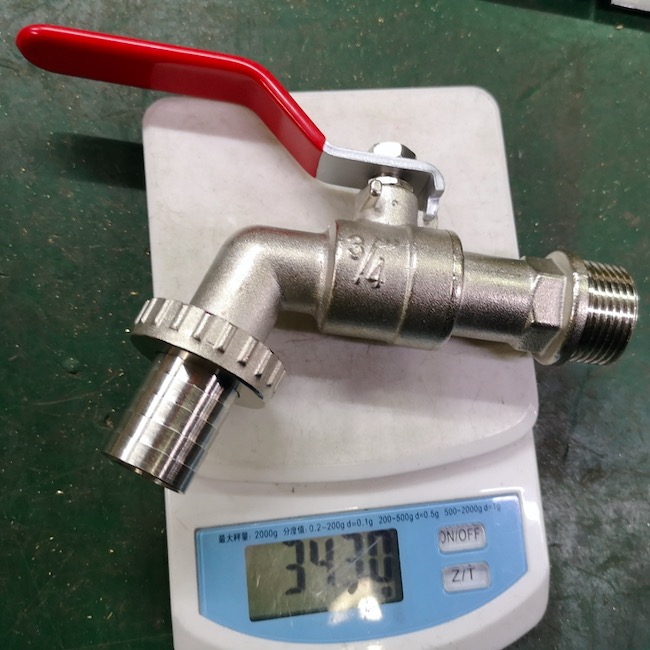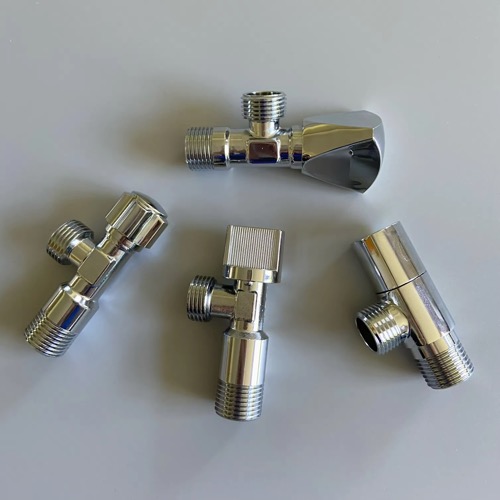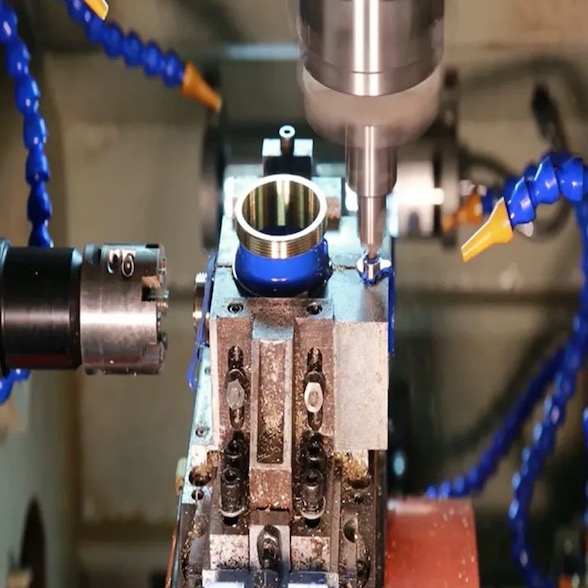Table of Contents
ToggleI. Introduction
Definition of Brass Ball Valve
What is a Brass Ball Valve? A brass ball valve is a type of valve used for controlling the flow of liquids and gases. It features a spherical closure unit, or "ball," which has a hole through its center to allow or obstruct flow when the valve is open or closed. The ball is rotated by a handle or lever attached to the valve stem. The ball has a central hole (bore) that aligns with the flow path when open and blocks it when turned 90 degrees.
Importance of Brass Ball Valves
Reliable Flow Control:
Brass ball valves provide precise and reliable control over the flow of liquids and gases with a simple quarter-turn mechanism, ensuring efficient operation.
Durability:
Made from brass, these valves exhibit excellent durability and resistance to corrosion, making them suitable for both residential and industrial environments.
Versatility:
Due to their robust construction and resistance to various types of corrosion, brass ball valves are suitable for a wide range of applications, from home plumbing to industrial processes.
Easy Operation and Maintenance:
The straightforward design of brass ball valves allows for easy operation, quick installation, and minimal maintenance. This reduces the overall downtime and operational costs.
High-Pressure Tolerance:
Brass ball valves can handle higher pressures compared to some other types of valves, making them ideal for applications requiring robust and reliable flow control.
Leak Prevention:
With their tight sealing mechanisms, brass ball valves minimize leakage, enhancing system efficiency while reducing potential environmental harm
Applications of Brass Ball Valves
Residential Plumbing:
Water Supply: Used in domestic water supply lines to control the flow of water to various household fixtures.
Heating Systems: Involved in regulating the flow of heated water in radiators and other heating systems.
HVAC Systems:
Cooling and Heating: Essential in the regulation of fluids in cooling and heating systems within residential, commercial, and industrial buildings.
Chillers and Boilers: Control the flow of water and other fluids through complex HVAC systems.
Industrial and Manufacturing:
Chemical Processing: Used to control the flow of chemicals, ensuring precise and safe operations.
Oil and Gas Industry: Applied in pipelines and storage systems to control the flow of oil and gas, providing reliable shut-off capabilities.
Food and Beverage: Employed to regulate the flow of ingredients and finished products through processing equipment.
Irrigation Systems:
Agricultural Use: Control water flow in large-scale agricultural irrigation systems, helping to efficiently manage water usage.
Fire Protection Systems:
Sprinkler Systems: Integral in controlling water flow to fire sprinkler systems, ensuring rapid delivery of water in case of a fire.
Automotive:
Fuel Systems: Involved in regulating the flow of fuel in automotive and machinery applications, ensuring efficient performance.
Marine Applications:
Vessel Plumbing: Utilized in the plumbing systems of boats and ships, controlling the flow of water and other fluids.
Specialized Applications:
Gas Lines: Suitable for controlling the flow of natural gas or propane in various systems.
Medical Equipment: Sometimes employed in medical and laboratory equipment for precise fluid control.
II. Why Use Brass Material for Brass Ball Valves?
Benefits of using brass as a material
Benefits of Using Brass for Brass Ball Valves
1. **Corrosion Resistance**:
- Brass has excellent resistance to corrosion, making it suitable for use in environments where it may be exposed to moisture and various chemicals. This property ensures the longevity and reliability of the valve.
2. **Durability**:
- Brass ball valves are robust and can withstand wear and tear over time. Their durability makes them ideal for both residential and industrial applications, ensuring they perform well under pressure.
3. **Ease of Operation**:
- The design of brass ball valves allows for easy operation with a simple 90-degree turn to open or close the valve. This quick action is particularly beneficial in situations requiring rapid response.
4. **Efficient Flow Control**:
- Brass ball valves provide efficient flow control with minimal pressure drop. Their full-bore design allows for unobstructed flow, making them suitable for high-flow applications.
5. **Versatility**:
- Brass ball valves can handle a wide range of fluids, including water, gas, and oil, across various temperatures and pressures. This versatility makes them applicable in diverse settings, from plumbing systems to industrial processes.
6. **Cost-Effectiveness**:
- Compared to other materials like stainless steel, brass is often more affordable while still providing reliable performance. This cost-effectiveness makes brass ball valves an attractive option for many projects.
7. **Ease of Maintenance**:
- The simple design of brass ball valves allows for easy maintenance and repair. Components can be disassembled without special tools, facilitating straightforward cleaning or replacement.
8. **Good Sealing Performance**:
- Brass ball valves typically feature effective sealing mechanisms that prevent leaks when closed. The sealing surfaces are isolated from the flow when the valve is fully open or closed, reducing wear from the medium.
9. **Lead-Free Options**:
- With increasing regulations regarding lead content in plumbing materials, many manufacturers offer lead-free brass options that are safe for potable water applications, ensuring compliance with health standards.
10. **Wide Range of Applications**:
- Brass ball valves are widely used in residential plumbing, HVAC systems, irrigation, and industrial applications due to their reliability and performance characteristics.
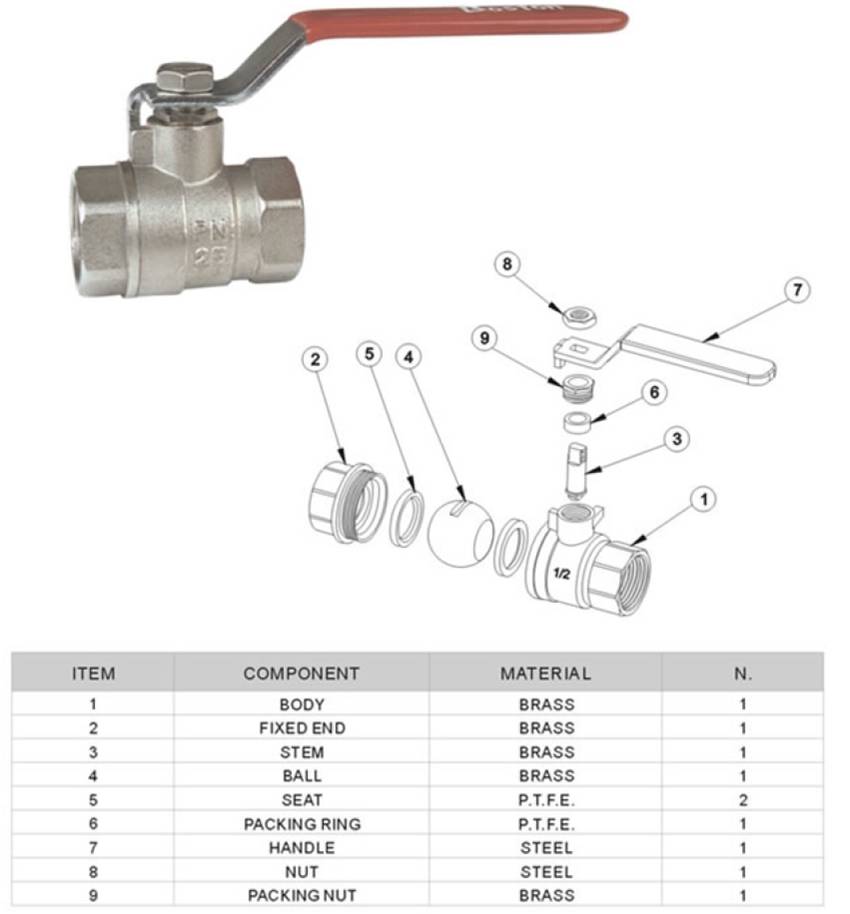
brass pex ball valve
III. Main Components of a Brass Ball Valve
A. Body:The main framework that houses all the internal parts.
B. Ball:A spherical component with a hole (bore) through its center.
C. Stem:A shaft that connects to the ball and allows for rotation.
D. Seat:Soft or hard rings that create a seal between the ball and the valve body.
E. Handle or Lever:The part used to turn the stem, which in turn rotates the ball.
F. Seals and O-rings:The part create a seal between the stem and the valve body.
IV. How Brass Ball Valves Work
Brass ball valves operate on a straightforward yet effective principle, utilizing a rotating ball to control fluid or gas flow. With components like the body, ball, seats, stem, and handle, these valves offer reliable and easy-to-use flow control. Their simplicity, combined with the durability and corrosion resistance of brass, makes them ideal for a wide range of applications in various industries. Whether manually operated or automated, brass ball valves ensure efficient and dependable performance.
V. Types of Brass Ball Valves
A. Full Port vs. Standard Port vs. Reduced Port
Feature | Full Port Brass Ball Valve | Standard Port Brass Ball Valve | Reduced Port Brass Ball Valve |
Diameter | Same diameter as the pipe it connects (full bore) | Typically one pipe size smaller than the connecting pipe | The bore with the valve is smaller sized compared to the diameter of the valve |
Port Opening | Bore opening of 90-100% of the valve | 75%-90% opening of the valve | bore opening is reduced up to 40% of the valve |
Flow Characteristics | Allows for unobstructed flow with minimal pressure drop | Reduced flow area can lead to pressure drop and cavitation | Similar to Standard port |
Applications | Ideal for applications with liquids and solids, such as water heaters and systems with sediment | Suitable for gaseous media or applications where flow is not critical | Good for application that does not require a full flow |
Cost | Generally more expensive due to larger size and material requirements | More cost-effective and compact, requiring less material | Even cheaper than standard port |
Space Requirements | Requires more space due to larger body size | More compact design, making it suitable for tight spaces | More compact design, making it suitable for tight spaces |
Performance | Maintains consistent flow pressure; reduces wear over time | May experience wear due to reduced flow area and potential cavitation | May experience wear due to reduced flow area and potential cavitation |
Installation Considerations | May require more robust support due to weight and size | Easier to install in confined spaces due to smaller size | Similar to Standard port |
B. Two-Way and Three-Way Ball Valves
Ball valves come in various configurations, with two-way and three-way valves being among the most common. Each type serves different purposes and offers unique advantages. Here's a detailed look at these two configurations to help you understand their differences and applications.
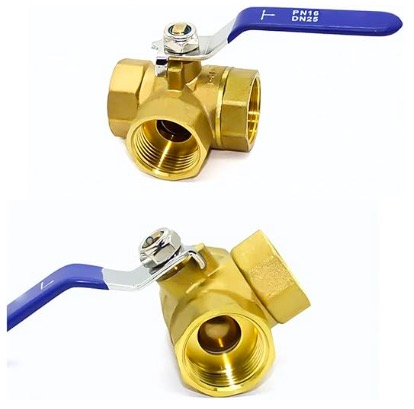
3 way brass ball valve 12"-2"
Key Differences
- **Flow Control:** Two-way valves provide simple on/off control, while three-way valves offer the ability to mix, combine, or divert flow.
- **Complexity:** Two-way valves are straightforward and easy to operate, whereas three-way valves have more complex functionalities suitable for advanced applications.
- **Versatility:** Three-way valves are more versatile, enabling control over more intricate fluid paths compared to the binary on/off of two-way valves.
Summary
Both two-way and three-way brass ball valves are essential components in fluid control systems. Two-way valves are perfect for straightforward, on/off applications and are widely used for their simplicity and reliability. In contrast, three-way valves provide greater flexibility and control, making them suitable for more complex tasks such as mixing and diverting flows. The choice between the two depends on the specific requirements of your application. Brass construction ensures that both types of valves are durable, corrosion-resistant, and dependable for long-term use.
C. Threaded and Soldered Connections
Key Differences
Installation Ease: Threaded connections are simpler to install and require no special tools, while soldered connections need professional skills and equipment.
Reusability: Threaded valves can be easily removed and reused, whereas soldered valves form a permanent bond that’s more difficult to alter.
Sealing Quality: Soldered joints generally provide a more reliable, leak-free seal compared to threaded connections.
Application Suitability: Threaded connections are excellent for temporary installations and low-pressure systems, while soldered connections are better for permanent, high-pressure, and high-temperature applications.

1" brass solder ball valve
VI. Installation and Maintenance Tips
Installation Tips
1. Choose the Right Valve:
Application Suitability: Ensure you select a brass ball valve that is appropriate for your specific application, considering factors such as pressure, temperature, and the type of fluid.
Connection Type: Decide between threaded, soldered, or other connection types based on your system requirements and ease of future maintenance.
2. Prepare the Pipes:
Clean the Pipes: Ensure that the pipes are clean and free from debris. For soldered connections, remove any oxidation or residues.
Check Threading: For threaded connections, make sure the threads are clean and undamaged.
3. Use Proper Sealing Techniques:
Threaded Connections: Apply pipe joint compound or Teflon tape to the threads to ensure a tight seal. Wrap the Teflon tape in the direction of the threads.
Soldered Connections: Use flux for soldering to prevent oxidation and ensure a good bond. Heat evenly and apply solder until it flows uniformly into the joint.
4. Installation Process:
Align Properly: Ensure the valve is aligned correctly with the pipe. For threaded connections, screw the valve on by hand first, and then use a wrench to tighten it, avoiding over-tightening to prevent thread damage.
Soldered Installations: Heat the joint evenly and apply solder, allowing it to flow into the joint completely. Ensure there are no cold spots.
5. Verify Proper Operation:
Function Check: After installation, open and close the valve several times to ensure it operates smoothly without any sticking or binding.
Leak Check: Once installed, check for leaks by pressurizing the system and inspecting around the valve. For soldered connections, look for any signs of incomplete solder flow.
Maintenance Tips
1. Regular Inspections:
Check for Leaks: Periodically inspect the valve and its connections for any signs of leaks. Pay attention to changes in system pressure or unusual moisture around the valve.
Valve Operation: Open and close the valve occasionally to ensure it moves freely and hasn’t become seized.
2. Cleaning:
External Cleaning: Keep the exterior of the valve clean to prevent dust and debris from interfering with the operation.
Internal Cleaning: If the system allows, periodically flush the valve to remove any deposits or contaminants inside.
3. Lubrication:
Moving Parts: Lubricate the valve stem and other moving parts with a suitable lubricant to ensure smooth operation. Avoid over-lubricating, which can attract dust and debris.
4. Handle Care:
Check Handle Condition: Inspect the valve handle for any signs of wear or damage. Ensure it is securely attached and functioning properly.
Gentle Operation: Avoid excessive force when operating the valve to prevent damage to the handle or internal components.
5. Address Corrosion:
Monitor for Corrosion: Regularly check for signs of corrosion, particularly around the connections. Brass is corrosion-resistant, but not immune.
Preventive Measures: Use appropriate protective measures such as applying a corrosion inhibitor if the valve is exposed to corrosive environments.
6. Periodic Replacement:
Replace Worn Seals: Seals and packing might wear out over time. Replace any worn or damaged seals to maintain a good seal and prevent leaks.
End-of-Life Replacement: Over time, ball valves can wear out. Replace the valve if it shows signs of significant wear, leakage that cannot be fixed, or difficulty in operation.
VII. Frequently Asked Questions (FAQs)
A. What sizes do brass ball valves come in? U
- Usually 1/4”, 3/8” 1/2”, 3/4” 1”, 11/4”, 11/2”, 2” and up to 4” brass ball valve
B. Can brass ball valves be used for gas?
-Yes, brass ball valve can be used for water, oil and gas.
C. How do I know if my brass ball valve needs to be replaced?
- 1. Leaking at the Handle or Pipe
- 2. Obvious Corrosion
- 3. Reduced Flow Rates
- 4. Valve Gets Stuck or Won't Close Completely
- 5. Ball Valve Jamming
- 6. A Closed Ball Valve That Leaks
- 7. Increased Noise or Vibration
D. Are brass ball valves suitable for high-pressure systems?
-Yes, we have brass ball valve at PN40, can be high-pressure systems.
If you have any inquiry or question for the brass pex fittings or brass ball valves, welcome to contact us.
Related Posts:
*Pex Pipe Sizes, Thickness and Pex Color – Ultimate Guide
*Top 5 PEX Pipe Manufacturers 2024
*How many types of brass fittings for pex pipe connection?
*HPB58-3A vs CW617N vs CW602N, what’re the differences from these brass pex fittings raw materials?



